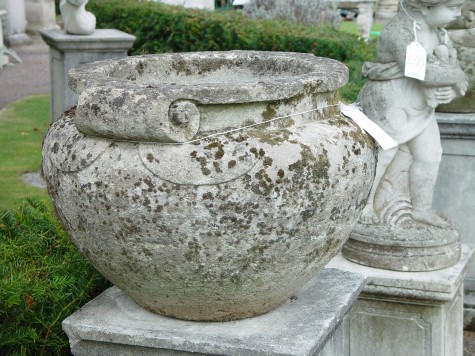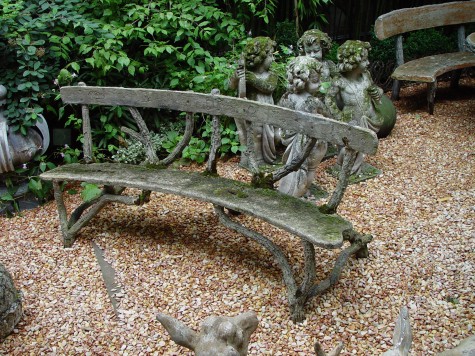 The word patina refers to an oxide that forms on a metal surface. Metals react with oxygen in ways that change their surface. The most dramatically obvious patina is rust. Iron and steel exposed to weather will rust; a patina of iron oxide will form on its surface, eventually corroding that surface. The shiny orange brown color of new copper will turn turquoise/green and brown with exposure to the weather. Bronze and lead both acquire patina, with time. How surfaces behave, withstand weather, or deteriorate outdoors is topic of much concern to people who either manufacture or collect garden ornament. But in regard to objects used or displayed outdoors, patina can more broadly refer to any material whose surface has been altered by age and exposure to the elements. This English antique stone urn has a surface that clearly has aged. The stone has become pitted and worn; these open stone pores have provided a foothold for colonies of lichens. Able to withstand extended periods of time with no water, lichens spring back to life after a rain sufficient such that the stone absorbs water. This weathered quality of the surface of this pot, surely much different than its new surface, is what I call beautiful patina.
The word patina refers to an oxide that forms on a metal surface. Metals react with oxygen in ways that change their surface. The most dramatically obvious patina is rust. Iron and steel exposed to weather will rust; a patina of iron oxide will form on its surface, eventually corroding that surface. The shiny orange brown color of new copper will turn turquoise/green and brown with exposure to the weather. Bronze and lead both acquire patina, with time. How surfaces behave, withstand weather, or deteriorate outdoors is topic of much concern to people who either manufacture or collect garden ornament. But in regard to objects used or displayed outdoors, patina can more broadly refer to any material whose surface has been altered by age and exposure to the elements. This English antique stone urn has a surface that clearly has aged. The stone has become pitted and worn; these open stone pores have provided a foothold for colonies of lichens. Able to withstand extended periods of time with no water, lichens spring back to life after a rain sufficient such that the stone absorbs water. This weathered quality of the surface of this pot, surely much different than its new surface, is what I call beautiful patina.
 The surface of these old iron cisterns probably bears little resemblance to their surface when the new iron was first cast. The hot rolled, pickled and oiled steel that Buck uses to create boxes and pots is all about a resistance to any patina. When hot rolled steel comes out of the rollers, structural steel shapes are sprayed with a chemical that forms what is called millscale; this dirty, crusty surface coating makes the steel look dark grey. Plate steel or coiled steel plate is pickled; this chemical bath is designed to delay the formation of rust. A spray of oil over the pickled steel further protects it. Suffice it to say that welding steel is a very dirty business. These cisterns have acquired a patina of both rust and moss; a surface that stays moist is an ideal home for moss. The color of this aged surface is subtly beautiful.
The surface of these old iron cisterns probably bears little resemblance to their surface when the new iron was first cast. The hot rolled, pickled and oiled steel that Buck uses to create boxes and pots is all about a resistance to any patina. When hot rolled steel comes out of the rollers, structural steel shapes are sprayed with a chemical that forms what is called millscale; this dirty, crusty surface coating makes the steel look dark grey. Plate steel or coiled steel plate is pickled; this chemical bath is designed to delay the formation of rust. A spray of oil over the pickled steel further protects it. Suffice it to say that welding steel is a very dirty business. These cisterns have acquired a patina of both rust and moss; a surface that stays moist is an ideal home for moss. The color of this aged surface is subtly beautiful.
 Concrete is a very porous material. Comprised of portland cement, sand, and aggregate rock, its surface weathers dramatically, given enough time. The antique faux bois bench is probably 80 years old; its surface tells that story. The Italian stone putti in the background are carved from stone native to Vincenza, Italy. This stone is exceptionally porous when new, and ever more porous as it ages. The colonies of moss that have taken hold on these sculptures tell that story.
Concrete is a very porous material. Comprised of portland cement, sand, and aggregate rock, its surface weathers dramatically, given enough time. The antique faux bois bench is probably 80 years old; its surface tells that story. The Italian stone putti in the background are carved from stone native to Vincenza, Italy. This stone is exceptionally porous when new, and ever more porous as it ages. The colonies of moss that have taken hold on these sculptures tell that story.
Lead is a classic material for garden ornament. At one time it was considerably less expensive to produce ornament in lead, as opposed to stone or marble. It is completely durable, impervious to any number of century’s worth of weather; this makes it ideal for placement outdoors. Its soft and somber grey color is handsome in a garden. The densest of all metals, lead is is also very soft. A large urn will collapse on its own socle or foot, given sufficient time for gravity to do its job. I could make a mark in a lead surface with my fingernail; old lead has a decidedly graphic patina. Old lead will develop a white patina in spots; very old lead may be quite pale in color.

This lead cistern, arguably several hundred years old, evidences every day of that history, yet it still does the job for which it was made. It hold water.
 The patterns and shapes of this stone basket of fruit are blurred with age. I am sure that at one time, every grape and apple was precisely rendered. I do not miss that stage, long past. I like objects with a history, that tell a story of another garden at an earlier time. The oldest object in my garden is no more than 70 years old. I like when my new things settle in, and begin to look like they belong.
The patterns and shapes of this stone basket of fruit are blurred with age. I am sure that at one time, every grape and apple was precisely rendered. I do not miss that stage, long past. I like objects with a history, that tell a story of another garden at an earlier time. The oldest object in my garden is no more than 70 years old. I like when my new things settle in, and begin to look like they belong.
This antique English stone urn was at one time painted. Who knows the story of the gouge in the rim, or the circumstances by which the surface has shed paint and stone so dramatically. Garden antiques in perfect condition are rare. By the same token, garden antiques in deteriorated condition have a character that cannot be reproduced.. Like a garden, there is no substitute for age on a garden ornament.
 This antique English cistern was rough hewn from a solid piece of Cotswold stone at least several hundred years ago. The suface is populated with more than a few species of plants. The stone absorbs the water it contains, keeping all those plants on the surface happy and healthy. I am happy to report it has a new home now with a gardener who appreciates its age and patina.
This antique English cistern was rough hewn from a solid piece of Cotswold stone at least several hundred years ago. The suface is populated with more than a few species of plants. The stone absorbs the water it contains, keeping all those plants on the surface happy and healthy. I am happy to report it has a new home now with a gardener who appreciates its age and patina.

I know little of the hstory of this stone pediment, save that it is of English origin. The black patina which covers much of ther stone dates it to the Industrial Revolution-a time when the residue from burning coal patinated many architectural stone pieces. This aged surface is visually striking. Fragments such as this make a clear and compelling statement about time and nature.


Very interesting and informative post. I appreciate a piece’s patina and history, and am glad you enlightened us on the subject. I was unaware of the origin of the black patina on the stone pediment and did not realize it could date a piece as such.
Love this post! I would love to learn more about antique garden ornamental history. There’s nobody better than you to learn from!!